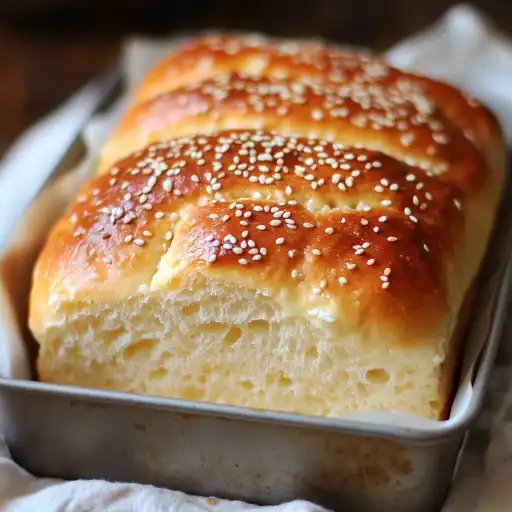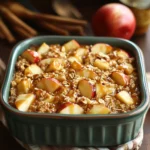Short Description
This Cloud Soft Everyday Bread recipe delivers a loaf that’s incredibly soft, tender, and versatile. It’s perfect for sandwiches, toast, or simply enjoying with a pat of butter. The simple ingredients and straightforward instructions make it a recipe you’ll turn to again and again.
Ingredients:
- 3 cups all-purpose flour
- 2 tablespoons granulated sugar
- 1 ½ teaspoons salt
- 2 ¼ teaspoons instant yeast (or active dry yeast)
- 1 cup warm water (105-115°F / 40-46°C)
- ¼ cup milk (whole or 2%)
- 2 tablespoons unsalted butter, softened
Optional Garnish:
- 2 tablespoons melted butter, for brushing
- Sesame seeds, for sprinkling
- Flaky sea salt, for sprinkling
Preparation:
Step 1: Combine Dry Ingredients: In a large mixing bowl, whisk together the flour, sugar, salt, and instant yeast. Make sure the yeast is evenly distributed.
Step 2: Add Wet Ingredients: Add the warm water, milk, and softened butter to the bowl with the dry ingredients.
Step 3: Mix the Dough: Stir the mixture with a wooden spoon or spatula until a shaggy dough forms. The dough will be quite sticky.
Step 4: Knead the Dough: Turn the dough out onto a lightly floured surface. Knead for 6-8 minutes, or until the dough becomes smooth, elastic, and bounces back when you gently poke it. If using a stand mixer, knead with the dough hook for 5-7 minutes.
Step 5: First Rise: Lightly grease a large bowl with cooking spray or oil. Place the dough in the bowl, turning to coat all sides. Cover the bowl with plastic wrap or a clean kitchen towel. Let the dough rise in a warm place for about 1 hour, or until it has doubled in size.
Step 6: Shape the Loaf: Gently punch down the dough to release the air. Turn it out onto a lightly floured surface. Shape the dough into a loaf that fits your loaf pan.
Step 7: Second Rise: Grease a 9×5 inch loaf pan. Place the shaped loaf into the prepared pan. Cover loosely with plastic wrap or a clean kitchen towel. Let the dough rise again for 30-40 minutes, or until it has nearly doubled in size and is puffy.
Step 8: Bake the Bread: Preheat your oven to 350°F (175°C).
Step 9: Bake: Place the loaf pan in the preheated oven and bake for 25-30 minutes, or until the bread is deep golden brown and sounds hollow when tapped on the bottom. If the top of the bread is browning too quickly, you can tent it with foil during the last 10 minutes of baking.
Step 10: Brush and Garnish: Remove the bread from the oven and immediately brush the top with melted butter. If desired, sprinkle with sesame seeds or flaky sea salt.
Step 11: Cool: Let the bread cool in the pan for 10 minutes before transferring it to a wire rack to cool completely before slicing and serving.
Why you’ll love this recipe
This bread is incredibly soft and has a subtle sweetness that makes it irresistible. It’s easy to make, requiring only simple ingredients and basic techniques. The recipe is also quite forgiving, making it perfect for beginner bakers.
Serving Suggestions:
- Make delicious sandwiches with your favorite fillings.
- Toast slices and spread with butter, jam, or avocado.
- Serve alongside soups and salads.
- Use it to make French toast or bread pudding.
- Enjoy it simply with a pat of butter or a drizzle of olive oil.
Tips:
- Make sure your water is warm, but not too hot, to activate the yeast properly.
- If using active dry yeast instead of instant yeast, dissolve it in the warm water with a pinch of sugar and let it sit for 5-10 minutes until foamy before adding it to the other ingredients.
- Don’t over-knead the dough, as this can result in a tough bread.
- If your loaf pan is not non-stick, grease it well with butter or cooking spray to prevent the bread from sticking.
- To ensure even baking, rotate the loaf pan halfway through the baking time.
- Let the bread cool completely before slicing to prevent it from becoming gummy.
Preparation Time: 20 minutes
Cook Time: 25-30 minutes
Total Time: Approximately 2 hours 30 minutes (including rising time)
Nutrition Information: (Approximate, per slice – based on 12 slices per loaf)
- Calories: 180
- Protein: 5g
- Sodium: 250mg
Conclusion
Cloud Soft Everyday Bread is a recipe that will quickly become a staple in your kitchen. Its soft texture, simple ingredients, and versatility make it a winner for any occasion. Whether you’re making sandwiches, toast, or simply enjoying a slice with butter, this bread is sure to please.
Questions and Answers about this recipe:
Q1: Can I use whole wheat flour instead of all-purpose flour?
A: Yes, you can substitute up to half of the all-purpose flour with whole wheat flour for a slightly nuttier flavor and added fiber. Keep in mind that whole wheat flour absorbs more water, so you may need to add an extra tablespoon or two of water to the dough. The texture will also be slightly denser.
Q2: Can I make this recipe without milk?
A: Yes, you can substitute the milk with more warm water or a non-dairy milk alternative like almond milk or soy milk. The milk adds a bit of richness and flavor, but the bread will still be delicious without it.
Q3: How do I know if my bread is done baking?
A: The best way to tell if your bread is done is to check its internal temperature with a thermometer. It should reach 200-210°F (93-99°C). If you don’t have a thermometer, you can tap on the bottom of the loaf. If it sounds hollow, it’s likely done. You can also check the color – it should be a deep golden brown.
Q4: Can I freeze this bread?
A: Yes, this bread freezes very well. Allow the bread to cool completely before wrapping it tightly in plastic wrap and then in a freezer bag. You can freeze it for up to 2-3 months. To thaw, simply leave it at room temperature for a few hours or overnight.
Q5: What if my dough doesn’t rise?
A: There are a few reasons why your dough might not rise. First, make sure your yeast is still active. You can test it by dissolving a teaspoon of yeast in a ¼ cup of warm water with a teaspoon of sugar. If it doesn’t foam up after 5-10 minutes, your yeast is likely dead. Also, make sure the water you’re using isn’t too hot, as this can kill the yeast. Finally, the temperature of your rising environment can affect the rise. A warm, draft-free place is ideal. If your kitchen is cold, you can try placing the dough in a slightly warmed oven (turned off!) or near a warm appliance.




